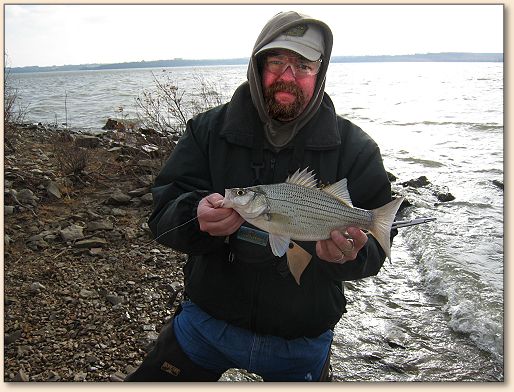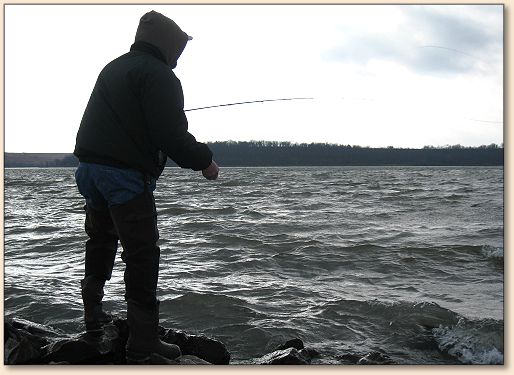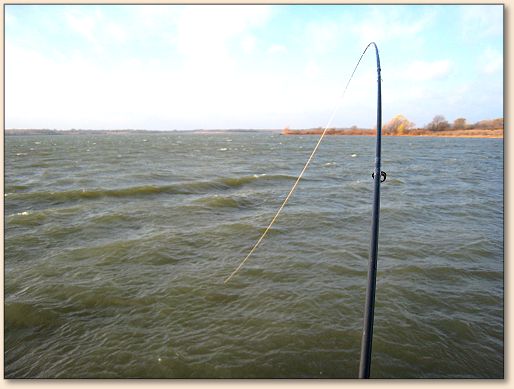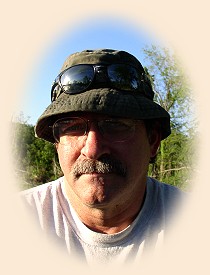|
The November 20, 2007 weather report called for a 25-to-35 mph
wind from the south and the forecasters hit the nail on the head.
Numbers like 25 and 35 don't by themselves bring to a reader's
mind what a chilly wind of such velocity feels like. Words
don't do the job very much better, but I'll try.
For openers, once we rendezvoused at Melvern Lake I followed
Tim Giger's pickup to the spot he wanted us to fish. We parked,
he opened his driver's side door, stepped out and before he
could stand up straight his ball cap was blown off his head
and went tumbling away across the ground. He chased it down,
pounced on it and screwed it down tight onto his skull.
Observing this track meet through my windshield I was duly
impressed. Before opening my own truck door I removed the
ball cap I was wearing and pulled on a stocking cap. Less
wind resistance.
As I'd learned earlier by fishing with him for wipers off
the face of the dam at Clinton Lake, Tim is a practitioner
of casting into the wind. He doesn't simply do this for
the exercise; he's seriously trying to catch fish. And
catch them he does. Today at Melvern Lake in cloudy,
windy northeast Kansas, white bass were his target.
"This entire rocky shoreline," Tim said, looking east and
west along the shore, "is great for white bass this time
of year. Any time a brisk south wind is blowing they'll
be here where the waves hit the shore straight on. I brought
a 6-wt. and a 7-wt. rod today; both are rigged with sinking
tip line to help me throw into this wind easier. What are
you using?"
"Uh," I mumbled hesitantly, "a 9-ft. 3-wt. I know you told
me we'd be throwing into the wind but this is the stoutest
rod I own."
I'm fairly accustomed to feelings of technical inadequacy,
not to mention outright ignorance, anytime I find myself
in the company of better geared, more knowledgeable fly
fishers (of which there are many who reside in the Sunflower
State). Tim may have sensed this; he generously offered
me the use of either of the heavier rods he'd brought.
Very tempting and had the wind conditions not been so hostile
I might have taken him up on his offer just so I could
experience throwing a couple of rods I've never tried
before. But the risk seemed too great that something,
perhaps my casting stroke, would go haywire so horribly
that I could damage his equipment. Only by standing
there in my shoes feeling that wind would you understand.
Tim took up a position on a rocky point that pokes into
the lake a little ways away from the shoreline. (This
is a good spot because it creates an underwater "barricade"
that minnow-herding white bass can utilize from both sides.)
He hadn't been casting into the headwind more than a couple
of minutes when he connected with his first fish, a nice
white bass.

This was a day when I got an education on the importance
of using gear adequate to the task. Tim with his heavier
rod and sink tip line was delivering his fly 20 feet out
with fair consistency. Whereas I was having extreme
difficulty getting my fly more than 10 feet past the
shoreline – and those successes were random instances
when the wind suddenly eased back to maybe 20 mph just
as I was starting my final forward stroke. Despite
every effort involving horsepower and finesse, most of
my casts sent the fly no farther out than a foot or two
past the toes of my shoes. Many times my casts – all
of my line, leader and fly – would plunk onto the ground
at my feet and not even make it into the water.
With my 3-wt. rod, I realized that I'd brought a boy to
do a man's work. Tim, on the other hand, he knows the
deal; he'd brought two strong men to do the work and as
a result his casting stroke consistently functioned as
designed. Nothing spectacular distance-wise but he was
certainly getting the job done.

After struggling with the headwind for nearly an hour,
staying in the same general area where Tim was, I felt
my casting arm weakening. The only way I could keep
fishing was to relocate to the west side of the main
point we were fishing from. This idea didn't exactly
fill me with confidence, as earlier Tim had explained
how white bass love to hunt minnows along rocky shorelines
where the wind and waves come in at a right angle to the
shore.
Nevertheless, I couldn't function effectively where we
were so I opted for a shoreline where the wind was sweeping
along in front of me, blowing left-to-right. Big waves,
big wind, both forces pushing every cast off target far
right, not only while the line was in the air during
delivery but in the water, too, immediately after the
fly touched down. The fly would hit the water and scoot
right at high speed, the floating line dragged along by
wave action.
I was using the largest, heaviest beadhead woolly bugger
in my fly box in hopes that by giving my floating line
slack the bugger could somehow settle into the water
column to decent depth. Apparently I did something
right because after ten minutes without a hit something
suddenly yanked my chain and I had a fish on.
By now the muscles in my casting arm and right wrist
were going into vapor lock. Whereas the strain earlier
had been caused by throwing straight into the headwind,
now at this new spot it was the relentless demand of
controlling my rod in the powerful crosswind that was
tiring me out. And Murphy's Law: this hooked fish
elected to flee south, into the wind, so I now had to
overcome both the fish's impressive strength plus the
stout crosswind resistance.

The sound this configuration made is not unlike how a
storm wind sings through the rigging of a sailboat.
Let me tell you, hearing that sound took a lot of the
sting out of my right wrist.
After beaching and unhooking the fish – it was a white
bass – I released it. Tim, who'd seen the fight, came
over and we evaluated the situation.
"Today with this high south wind we have perfect conditions
for white bass to be prowling this shoreline, in tight,
real close," he reported. "We both would be catching
lots of whites right now if the wind was just 10 mph
lighter. But it's too much today – too much for us."
Boy I could have hugged him for saying that! So a few
minutes later we surrendered to the elements, packed up
our gear and headed home. Not many fish got caught this
day by either one of us, but it was a day well spent. I
certainly learned more from Tim about the unique strategies,
equipment and mental approach needed for scoring on white
bass in the big federal lakes of Kansas. ~ Joe
About Joe:
 From Douglas County, Kansas, Joe is a former municipal and
federal police officer, now retired. In addition to fishing, he hunts
upland birds and waterfowl, and for the last 15 years
has pursued the sport of solo canoeing. On the nearby
Kansas River he has now logged nearly 5,000 river miles
while doing some 400 wilderness style canoe camping
trips. A musician/singer/songwriter as well, Joe recently
retired from the U.S. General Services Adminstration.
From Douglas County, Kansas, Joe is a former municipal and
federal police officer, now retired. In addition to fishing, he hunts
upland birds and waterfowl, and for the last 15 years
has pursued the sport of solo canoeing. On the nearby
Kansas River he has now logged nearly 5,000 river miles
while doing some 400 wilderness style canoe camping
trips. A musician/singer/songwriter as well, Joe recently
retired from the U.S. General Services Adminstration.
Joe at one time was a freelance photojournalist who wrote the
Sunday Outdoors column for his city newspaper. Outdoor
sports, writing and music have never earned him any money,
but remain priceless activities essential to surviving the
former 'day job.'
|




 From Douglas County, Kansas, Joe is a former municipal and
federal police officer, now retired. In addition to fishing, he hunts
upland birds and waterfowl, and for the last 15 years
has pursued the sport of solo canoeing. On the nearby
Kansas River he has now logged nearly 5,000 river miles
while doing some 400 wilderness style canoe camping
trips. A musician/singer/songwriter as well, Joe recently
retired from the U.S. General Services Adminstration.
From Douglas County, Kansas, Joe is a former municipal and
federal police officer, now retired. In addition to fishing, he hunts
upland birds and waterfowl, and for the last 15 years
has pursued the sport of solo canoeing. On the nearby
Kansas River he has now logged nearly 5,000 river miles
while doing some 400 wilderness style canoe camping
trips. A musician/singer/songwriter as well, Joe recently
retired from the U.S. General Services Adminstration.